Picture this: A world in which there are no fees, delays, or middlemen to worry about when sending money to anybody, anywhere. You are not dependent on centralized authorities or third parties to confirm the legitimacy of any good, document, or asset. A future without courts or attorneys, where smart contracts can be created and carried out to enforce any agreement's terms and conditions automatically. This is now possible, thanks to blockchain technology.
According to Zippia, around 300 million people, or 3.9% of the global population, use blockchain technology for cryptocurrency. There are 82 million users of blockchain wallets worldwide.
What Exactly Is Blockchain and How Does It Work?
A distributed ledger, or blockchain, is a safe, open, and unchangeable record of transactions or data. A network of nodes that use cryptographic techniques to store and authenticate data maintains a blockchain, in contrast to traditional databases that are managed by a single entity.
Each node keeps a copy of the whole ledger on file, which is updated each time a new transaction or piece of data is added. A chain of blocks is created by connecting the blocks—which are groups of data—with a hash function. This guarantees that the network will identify and reject any effort to tamper with the data.
Blockchain technology is widely applied in the field of cryptocurrency, a type of digital money that operates independently of governments and central banks. However, blockchain technology is not limited to cryptocurrency use. In addition, it can be applied to supply chain management, digital identification, healthcare, and other areas!
As the technology develops and matures, there will be an increasing number of use cases, presenting opportunities as well as challenges to individuals, governments, and enterprises. While it's not a cure-all, blockchain technology is a potent instrument that can foster trust, innovation, and teamwork in the digital age.
Therefore, presenting to you “Introduction to Blockchain Technology and Its Applications” PowerPoint Presentation. This presentation will not only help you save time and effort but also enhance your presentation quality and overall professionalism.
Let me show you some of the PPT templates included in this professionally created presentation deck.
Note: All PPT templates are completely editable, which allows you to tailor them to your individual needs and interests.
COVER SLIDE
This is the cover slide of your PowerPoint presentation. Add your Company’s Name and start!
Cover slide is essential as it-
- It provides an introduction and acts as an icebreaker.
- It helps to set the tone of the presentation.
- Allows the presenter to grab their audience’s attention from the start.
What is Blockchain Technology?
This PPT slide provides an overview of the blockchain concept. Blockchain is a decentralized information recording technology that makes data difficult to update or hack once it is saved on its network. It includes important advantages of blockchain technology such as higher security, transparency, instant traceability, increased efficiency, and automation.
This PPT template serves as an overview, introducing the audience to the concept of blockchain. For those who are unfamiliar with blockchain, this slide provides a basic summary. It is like the first chapter of a book in that it provides an outline of the plot. This PPT slide aims to grab people's attention in addition to delivering information. Because of the illustrations and organization, it is straightforward to understand and remember. Download it now!
Major Components of Blockchain Technology
This PPT slide covers the major components of blockchain technology. The key elements of a blockchain are a ledger, smart contracts, consensus network, membership, events, systems management, wallet, and systems integration. This PPT template acts as a thorough manual for the presenter, dissecting intricate blockchain elements into easily understood ideas.
By providing a visual aid, the presenter can better engage the audience and explain the importance and workings of each key blockchain component. It gives the audience a clear grasp of the essential elements that combine to make blockchain technology revolutionary. Download it now!
Different Layers of Blockchain Technology
You may have heard of blockchain technology and its applications in various fields, such as finance, healthcare, supply chain, and more. But do you know how blockchain actually works? What are the different layers that make up a blockchain system?
This slide will explain the five essential layers of blockchain technology: application, consensus, network, data, and hardware. These layers interact with each other to create a secure, decentralized, and distributed ledger of transactions that can be verified by anyone. By learning the basics of blockchain technology, you will be able to understand how it can benefit your business and solve real-world problems. You will also be able to explore the possibilities of integrating blockchain with other technologies, such as artificial intelligence and crypto.
Know more about blockchain and blockchain education with our best PowerPoint templates. Download now!
Evolution Timeline of Blockchain Technology
Do you know how blockchain technology came to be? What were the key events and innovations that shaped its development? How did it go from a simple idea to a revolutionary technology that powers cryptocurrencies and many other applications?
This PPT slide will show you the evolution timeline of blockchain technology, from its origins in the 1990s to its current state in the 2020s. You will learn about the different stages of blockchain, such as:
- The first use of blockchain for time-stamping digital documents was in 1991.
- The release of the Bitcoin software in 2009 marked the birth of blockchain as the backbone of cryptocurrency.
According to a PwC report, 84% of executives said that their organizations are utilizing blockchain technology in some way. Blockchain technology is expected to generate $3.1 trillion in new commercial value by 2030.
If your audience is familiar with its history, they will see the potential and worth of blockchain technology for business and society. Easily customize and utilize this PowerPoint Bundle to create your own PowerPoint presentation in minutes! Download it now!
How Does Blockchain Work?
What happens when you use blockchain? Imagine you want to send some money to your friend using blockchain technology. How does it work? What are the steps involved in making a blockchain transaction?
This slide covers the process of blockchain operations. It includes various steps such as transaction request, block creation, network distribution, validation process, reward and confirmation, and transaction completion.
This PPT template can help you present to your clients and audiences how blockchain technology guarantees security, transparency, and efficiency for your transactions by becoming familiar with the operations process. They will also be able to recognize the advantages of blockchain technology and how it may be used in a variety of sectors, including supply chain, banking, and healthcare. Our templates, made by expert researchers, are also easy to use and modify so that you can add your personal touch to this PowerPoint presentation in minutes.
According to an IBM report, 91% of banks are investing in blockchain technology to improve their services. Blockchain technology is expected to save the banking industry $20 billion per year by 2022. Don’t be left behind- Download it now!
What is a Block in Blockchain, and How Does it Work?
Have you ever wondered what a blockchain technology block is? How is the data that you give and receive on the blockchain network processed and stored?
This slide will give you an overview of the concept of blocks in blockchain networks. You will learn about the functions of blocks, such as:
- Collection of transactions: A block is a data unit that lists all of the transactions—such as sending and receiving money, tokens, or other assets—that take place on the blockchain network.
- Security: When a block is added to the blockchain, it is difficult to alter or tamper with it because of a cryptographic problem known as proof-of-work.
By comprehending the idea of blocks in blockchain networks, you will be able to show your clients and businesses how blockchain technology functions and why it is so potent and inventive.
According to a report by Deloitte, 55% of global executives say that blockchain technology is a critical priority for their organization. Blockchain technology is expected to generate $176 billion in business value by 2025. Download this template today!
What are Blockchain Nodes and How Do They Work?
You may have heard that blockchain is a network of computers that work together to store and process information. But what are these computers and what do they do?
This slide provides an overview of the concept of nodes in blockchain networks. It also includes their functions, such as data propagation, consensus mechanism, network security, and transaction validation.
According to a Statista report, 11,000 nodes were operating on the Bitcoin network as of April 2021. Nodes depend on the blockchain network's functionality and security. You will be able to share how blockchain technology functions with your audiences/clients. This PPT slide also explains why it is so dependable and effective.
Grab this PPT bundle and your audience will be able to learn blockchain and blockchain education in a simple and interesting way. Download it now!
In a Nutshell
Our professionally made PowerPoint presentation, "Introduction to Blockchain Technology and Its Applications," concisely explains blockchain. This PowerPoint bundle covers everything, from fundamental knowledge of history to a variety of applications. It also discusses the idea of blocks in blockchain networks and emphasizes how important they are for data security.
In addition, the talk covers blockchain nodes and explains how these interconnected computers process and store data. Every slide uses images to make difficult ideas easier to understand. Whether you're new to blockchain or looking to educate your business partners or clientele, this PowerPoint bundle is a valuable resource. Download it now.
Click here to get a FREE PPT & FREE PDF!
We would love to hear your thoughts! Please leave a comment below if you found this article helpful or if you have any other ideas!
We've researched over 100,000 topics and designed over five million EDITABLE SLIDES and DOCUMENTS to give you a head start. Access ten original presentations for only $49.99!
FAQs
- Q: What is blockchain technology?
- A: Blockchain is a decentralized system recording information, known for security, transparency, and efficiency.
- Q: How does blockchain work?
- A: It processes transactions through steps like block creation, validation, and distribution, ensuring security.
- Q: What are the major components of blockchain?
- A: Components include ledgers, smart contracts, consensus networks, wallets, and systems integration.
- Q: In which fields can blockchain be applied?
- A: Blockchain finds applications in finance, healthcare, supply chain, and more, solving real-world problems.
- Q: Why is the evolution timeline important?
- A: Understanding blockchain's history, from 1990s origins to 2020s advancements, reveals its potential value.


![Top 7 Slides on Introduction to Blockchain Technology and Its Applications [Free PPT & PDF]](https://www.slideteam.net/wp/wp-content/uploads/2024/01/BANNER-13-1013x441.jpg)


 Customer Reviews
Customer Reviews



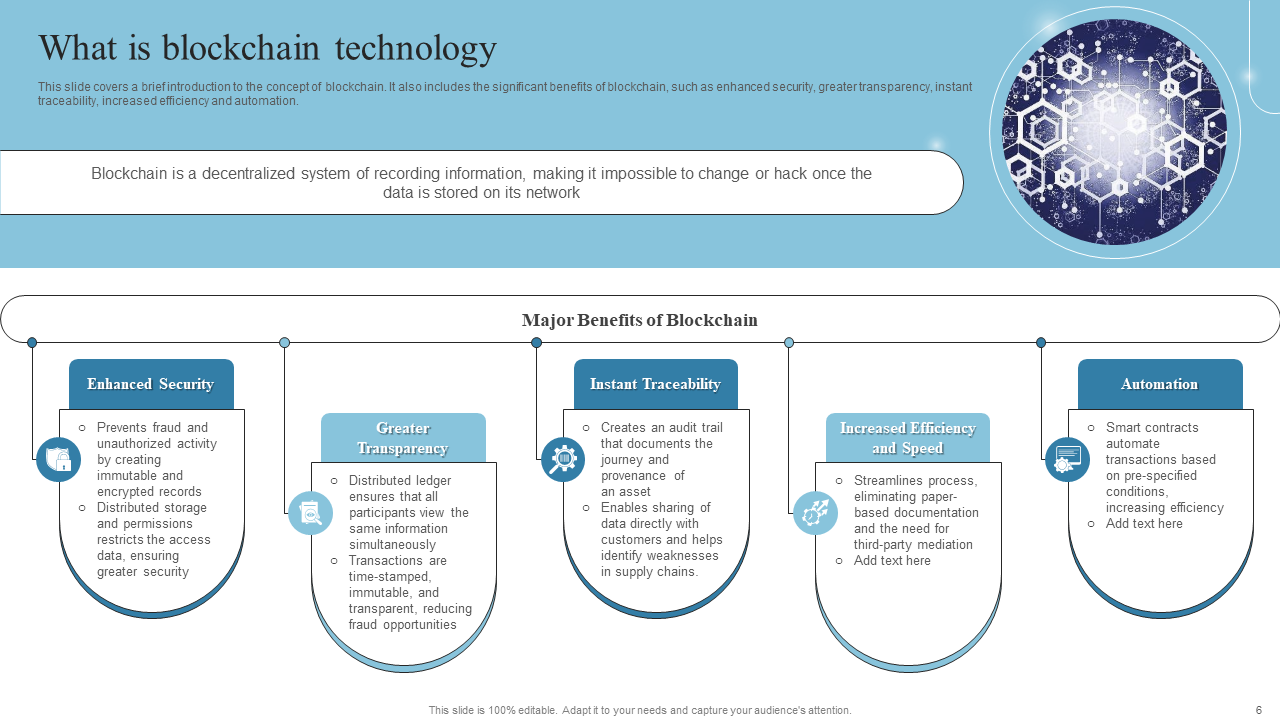
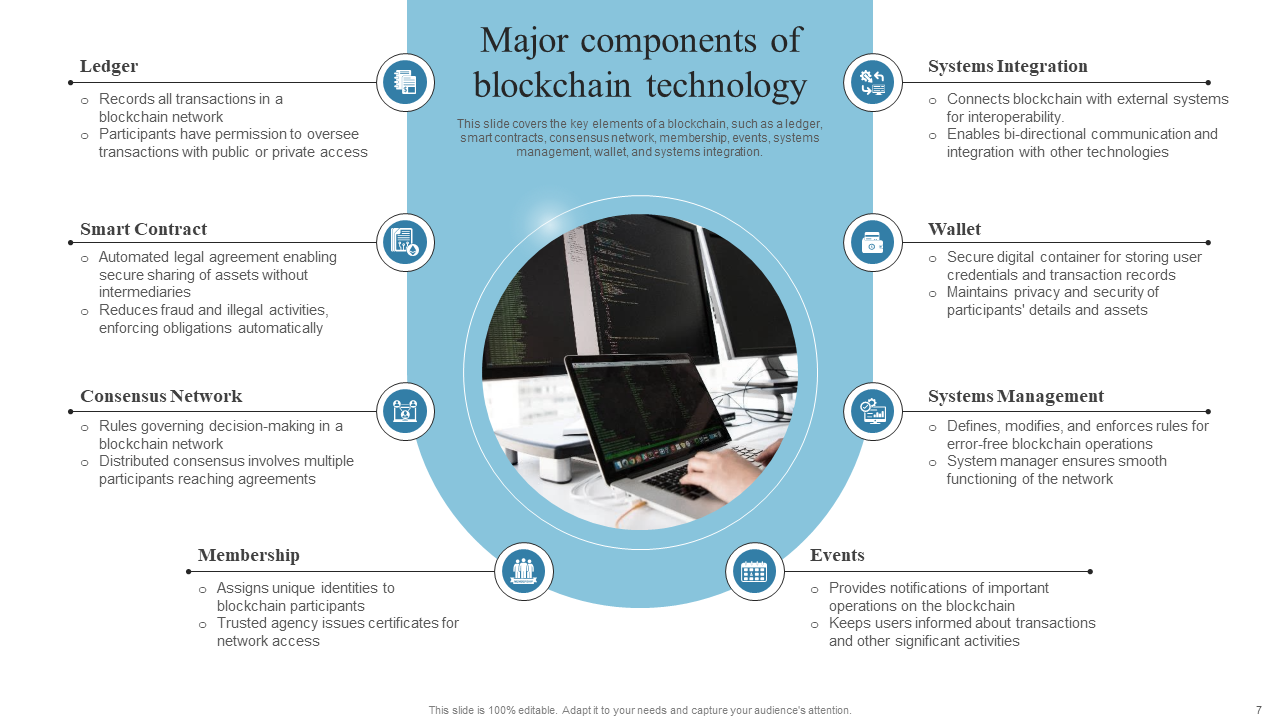
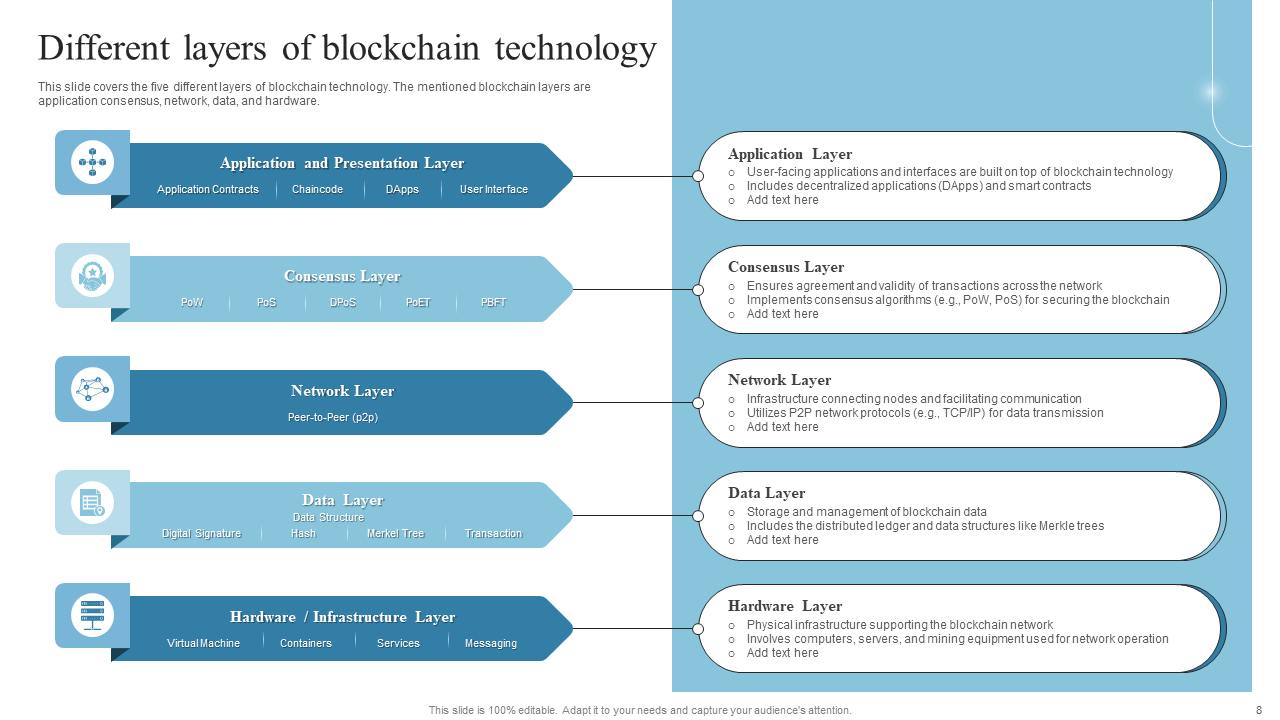
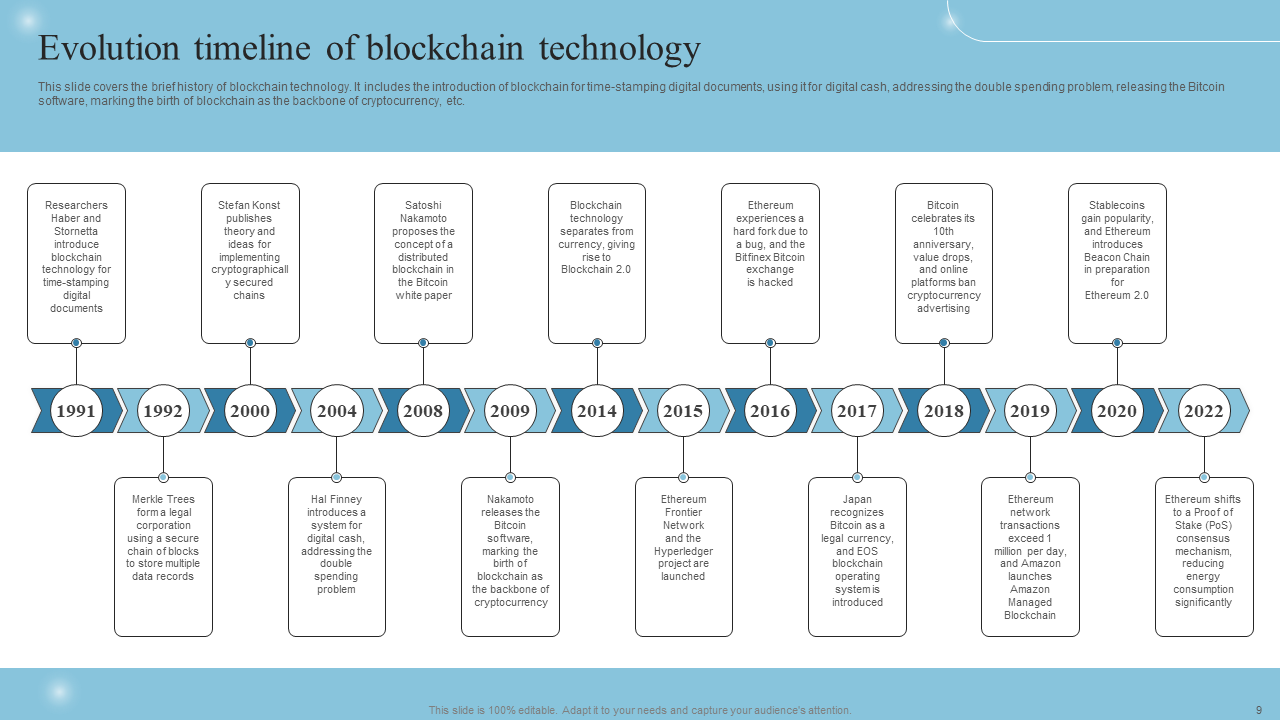

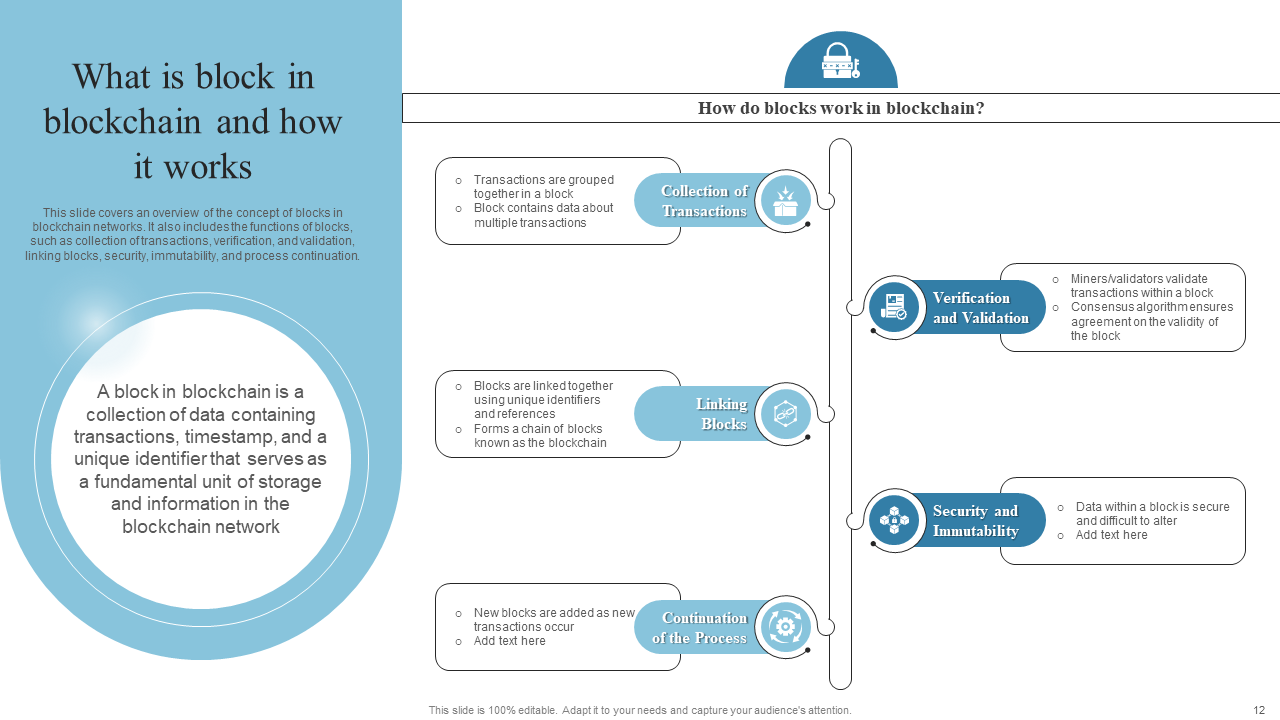





![Best Slides on ChatGPT for Creating AI Art Prompts [Free PPT & PDF]](https://www.slideteam.net/wp/wp-content/uploads/2024/01/BANNER-1-1-1013x441.jpg)
![Top Templates on Benefits of Employee Retention [Free PPT & PDF]](https://www.slideteam.net/wp/wp-content/uploads/2024/01/BANNER-7-1013x441.jpg)
![How to Raise Funds Through Initial Coin Offerings [Free PPT & PDF]](https://www.slideteam.net/wp/wp-content/uploads/2024/01/BANNER-8-1013x441.jpg)
![Top 10 slides on Google Bard! Future of Generative AI [Free PPT and PDF]](https://www.slideteam.net/wp/wp-content/uploads/2023/09/BANNER-3-1013x441.png)











